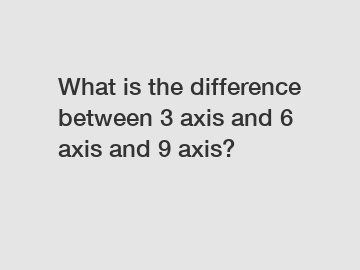What is the difference between 3 axis and 6 axis and 9 axis?
What is the Difference Between 3 Axis, 6 Axis, and 9 Axis?
In the field of robotics, different types of axis systems are used to describe the movement and capability of robotic arms. These axis systems, such as 3 axis, 6 axis, and 9 axis, determine the freedom of movement and the degrees of rotation that a robotic arm can achieve. Understanding the differences between these axis systems is crucial for selecting the right robotic arm for specific tasks. In this article, we will explore the characteristics and applications of 3 axis, 6 axis, and 9 axis robotic arms.
3 Axis Robotic Arms:

A 3 axis robotic arm refers to a system that operates with three degrees of freedom, allowing movement around three mutually perpendicular axes: X, Y, and Z. This means that the arm can move left-right, forward-backward, and up-down. The primary applications of 3 axis robotic arms are found in basic industrial processes, such as pick and place tasks, welding, and simple assembly operations. They are generally less complex and less expensive compared to higher axis systems, making them suitable for entry-level automation needs.
6 Axis Robotic Arms:
A 6 axis robotic arm is capable of moving in six directions, adding three additional rotary axes to the three linear axes of a 3 axis arm. The additional axes are responsible for rotation around each of the three primary axes (roll, pitch, and yaw). This allows the robotic arm to handle more complex tasks and achieve greater flexibility and dexterity. The versatility of 6 axis robotic arms makes them well-suited for applications in manufacturing, material handling, painting, and even medical surgery. The ability to rotate the end effector allows for precise control and manipulation of objects from various angles.
9 Axis Robotic Arms:
As technology advances, robotic arms with even more degrees of freedom have been developed. A 9 axis robotic arm is the next step in increasing the flexibility and range of motion. In addition to the six degrees of freedom provided by a 6 axis arm, a 9 axis arm includes additional rotation capabilities in each of the three axes. This additional complexity enables the arm to perform highly intricate movements, making it suitable for applications that require extreme precision, such as microsurgery and delicate assembly operations. The increased axis system also provides redundancy, ensuring that the arm can continue to function even if one axis fails.
Closing:
In conclusion, the choice between a 3 axis, 6 axis, or 9 axis robotic arm depends on the specific requirements of the application. A 3 axis robotic arm is ideal for basic tasks requiring movement in three linear directions, whereas a 6 axis arm provides greater flexibility for complex tasks. A 9 axis arm takes flexibility to the next level and is suitable for highly precise operations. By understanding the differences between these axis systems, it becomes easier to select the most appropriate robotic arm for a particular industry or task.
For more information on robotic arms and their applications, please contact us.
The company is the world’s best tilt switch manufacturers, gyroscope for drone, GNSS Survey Antenna supplier. We are your one-stop shop for all needs. Our staff are highly-specialized and will help you find the product you need.


